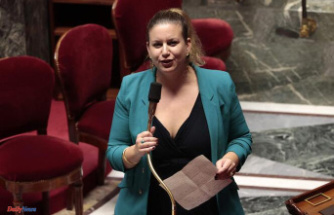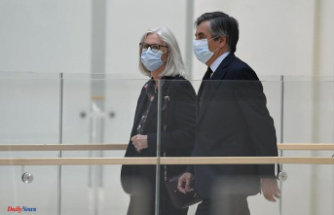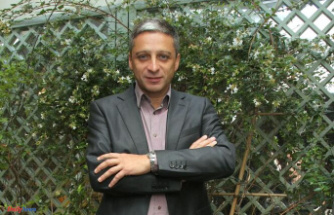Municipalities and federal states are registering a rapidly increasing number of asylum seekers who come to Germany via the Balkan route. They warn of a similarly dramatic situation as in 2015. What's going on there?
The "pressure to migrate is increasing" and for the first federal states "will soon be almost impossible to cope with" - the Saxon Minister of the Interior, Armin Schuster, leaves no doubt about how serious he is. Because the number of refugees who are currently entering Germany, mainly via the so-called Balkan route, is increasing. The CDU politician warns that this will lead to immense problems in accommodation. "We are heading for a situation like the one we had in 2016/17." Not only Saxony's Minister of the Interior draws this comparison. According to the German District Association, a situation similar to that of 2015, when the admission of people seeking protection resulted in an unprecedented effort for society as a whole.
Since the refugees from Ukraine do not have to apply for asylum, the dimensions in the official figures of these days are different: up to and including September 28, the federal police found around 56,800 unauthorized entries into Germany. Most people arrive in Bavaria and Saxony. From January to August, 15,433 unauthorized border crossings were registered by the federal police in Bavaria. In the same period of 2021 there were 8706. In Saxony, 7397 people who entered Germany illegally were found at the border sections with Poland and the Czech Republic, compared to 2402 in the same period of the previous year.
The Federal Office for Migration received around 115,000 new asylum applications nationwide by the end of August - an increase of just over a third compared to the previous year. Most of the people came from Syria, Afghanistan and Iraq. "All in all, we are expecting 200,000 asylum applications this year in addition to the approximately one million registered refugees from Ukraine," said the vice-chairman of the Union faction, Andrea Lindholz, to ntv.de. In Austria, the numbers are even higher: from January to August of this year, 56,000 people applied for asylum in the country with around nine million inhabitants. That was more than all of last year, but less than during the 2015 refugee crisis.
"So far, we have had a rather manageable increase in people seeking protection from other countries, which would not normally be discussed, but which are relevant due to the stress in the reception system," says Marcus Engler from the German Center for Integration and Migration Research in an interview with ntv .de. Because in addition to the people now arriving, there are an estimated one million war refugees from the Ukraine. "That creates a lot of stress, not in the asylum system, which Ukrainians don't fall under, but in the reception system. Above all with accommodation, but also with integration courses and counseling services," says Engler.
In many federal states, there is a growing fear that adequate care can no longer be guaranteed if the number of additional asylum seekers continues to rise. Bavaria, for example, has taken in almost 22,000 asylum seekers in addition to 148,000 war refugees from the Ukraine. In some places, capacities are already running out. There are around 150 unaccompanied minor refugees in Bochum, which is significantly more than usual, as WDR reports. Because the number of free places in the accommodation there is decreasing, a gymnasium has already been misappropriated as emergency accommodation for the young people. It's more reminiscent of 2015.
Federal Minister of the Interior Nancy Faeser recently expressed concern about the increasing number of people making their way to Germany via the Balkan route, and admitted a certain helplessness. "Why migration has suddenly increased so much," she still has to find out and announced a talk with Serbia.
In fact, Serbia seems to be a gateway to Europe. For example, people from India or Bangladesh enjoy visa-free travel there, so they can legally enter the country by air, for example. For many, however, going west is only illegal. "They are supported by established and mature smuggling structures," said a spokesman for the Federal Police.
According to the Austrian migration researcher Judith Kohlenberger, the reason why the number of refugees is increasing right now is also due to a seasonal effect. "We always experience a final increase in migration and refugee movements in late summer and early autumn," says Kohlenberger, who researches at the Vienna University of Economics and Business, ntv.de. She explains this phenomenon with a "now or never" effect: "Before the hike across the green border or even the Mediterranean crossing becomes impossible in winter, there is one last push."
The geopolitical situation also plays a role. According to Kohlenberger, the effects of the Russian war of aggression in Ukraine in particular, such as the lack of grain deliveries, increased the existential needs in the countries of the Global South. She is observing a shift to target countries with an increased need for labour. In Italy, Spain and Portugal there is an acute shortage of workers, many are hoping for work, for example as a harvest helper. "If people in Austria are picked up by the tightened border controls, they have little choice but to apply for asylum because otherwise they will be deported. Actually, they want to move on, for example in the direction of Germany. And that's what many of them then do also."
The German authorities are currently mainly registering people from classic asylum countries such as Syria and Afghanistan. This also puts the focus on Turkey, where refugees are to be kept out of the EU in exchange for billions in payments. A deal with no legal significance, but of proven fragility. President Recep Tayyip Erdogan is using the approximately four million Syrians in the country as leverage. The situation of the people there is precarious, many want to leave.
On Telegram, a Syrian refugee collective calls for an organized exodus from Turkey. Refugees should equip themselves with sleeping bags, tents, life jackets, drinking water, canned food and first aid kits. Convoys should be formed with a maximum of 50 people and a leader. The channel is followed by 70,000 people. "Unfortunately, it was foreseeable that Syrian refugees housed in Turkey would also make their way to the EU," said Kohlenberger. "That shows how unsustainable this externalization policy is."
The mixed situation on the Balkan route is difficult to survey. Kohlenberger does not see a new 2015, but it is quite obvious that more people are currently making the dangerous journey to the West. Austria has reacted to the increasing number of refugees and introduced focused controls at the eleven border crossings to Slovakia for ten days. CSU politician Lindholz is also demanding that Federal Interior Minister Faeser set up stationary border controls. The minister, in turn, wants to discuss a timetable for the winter with the municipalities at the refugee summit on October 11th.












